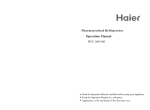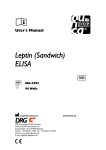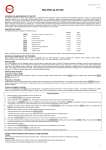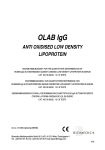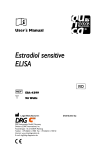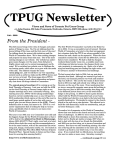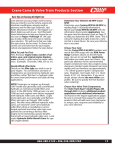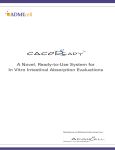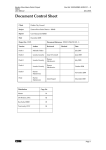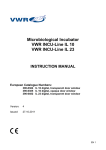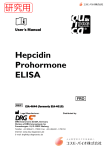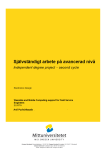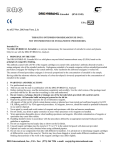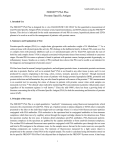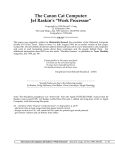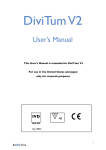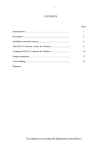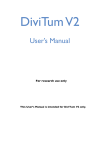Download Instructions for Use
Transcript
Instructions for Use CRP HYC-5319 80 tests Manufacturer: DRG Instruments GmbH, Germany Division of DRG International, Inc. Frauenbergstr. 18, D-35039 Marburg Telefon: +49 (0)6421-17000 Fax: +49-(0)6421-1700 50 Internet: www.drg-diagnostics.de E-mail: [email protected] Distributed by: DRG:HYBRiD.XL CRP Contents / Inhaltsverzeichnis / Contenuti / Contenido / Contenu 1 2 3 4 5 6 7 8 9 10 11 12 INTRODUCTION .................................................................. 3 PRINCIPLE OF THE TEST .................................................. 3 WARNINGS AND PRECAUTIONS ...................................... 3 REAGENTS.......................................................................... 3 SPECIMEN COLLECTION AND PREPARATION ............... 4 ASSAY PROCEDURE ......................................................... 4 QUALITY CONTROL ........................................................... 4 EXPECTED NORMAL VALUES .......................................... 5 LIMITATIONS OF USE ........................................................ 5 PERFORMANCE CHARACTERISTICS .............................. 5 METHOD COMPARISON .................................................... 5 LEGAL ASPECTS ................................................................ 6 13 REFERENCES / LITERATURE ........................................... 6 USED SYMBOLS .......................................................................... 7 Vers. 2.0 2015/02 – rl/vk -2- HYC-5319 DRG:HYBRiD.XL CRP 1 INTRODUCTION 1.1 Intended Use The DRG:HYBRiD-XL CRP is an immunoturbidimetric assay for the quantitative in vitro diagnostic measurement of C-reactive protein (CRP) in serum and plasma (heparin and citrate). Only for use with the DRG:HYBRiD-XL Analyzer. 1.2 Summary and Explanation Concentration of acute-phase proteins increase in blood as a response to inflammatory disorders (acute-phase response) (1,2). C-reactive protein (CRP), the best known member of this group, is present only at low concentration in blood of healthy individuals (< 5 mg/L), but is elevated up to 500 mg/L in the acute-phase response, caused by inflammatory processes associated with bacterial infections, post-operative conditions or tissue damage. CRP concentration increases already after 6 hours, reaching a peak after 48 hours. The measurement of CRP represents a useful laboratory test for detection of acute infection as well as for monitoring inflammatory processes in acute rheumatic (3) and gastrointestinal (4) diseases. CRP testing shows various advantages in comparison to the erythrocyte sedimentation rate (ESR) and the leukocyte count. In fact, CRP is more sensitive, shows earlier response and returns to reference range more rapidly after healing. 2 PRINCIPLE OF THE TEST The DRG:HYBRiD.XL CRP Kit is a immunoturbidimetric assay. It is based on an endpoint determination of the CRP concentration by photometric measurement of the antigen-antibody reaction between antibodies against human CRP and CRP that is present in the sample. 3 1. 2. 3. 4. 5. 6. 7. 8. 9. 10. 11. 12. 13. 14. 15. 16. WARNINGS AND PRECAUTIONS This kit is for in vitro diagnostic use only. For professional use only. This kit can only be used in combination with the DRG:HYBRiD-XL Analyzer Before starting the assay, read the instructions completely and carefully. Use the valid version of the package insert provided with the kit. Be sure that everything is clear and understood. Do not remove, exchange, discard or damage any of the barcode labels provided with each kit and its components. All barcodes build an integral system for the kit lot. Respect the general safety measures for use of laboratory reagents. All reagents of this test kit which contain human serum or plasma have been tested and confirmed negative for HIV I/II, HBsAg and HCV by FDA approved procedures. All reagents, however, should be treated as potential biohazards in use and for disposal. Never pipet by mouth and avoid contact of reagents and specimens with skin and mucous membranes. Do not smoke, eat, drink or apply cosmetics in areas where specimens or kit reagents are handled. Wear appropriate disposable gloves when handling specimens and reagents. Microbial contamination of reagents or specimens may cause false results. Handling should be done in accordance with the procedures defined by an appropriate national biohazard safety guideline or regulation. Do not use reagents beyond expiry date as shown on the kit labels. Unused reagent cartridges must be stored at 2 °C to 8 °C in the sealed foil pouch with desiccant provided. Optimal test results are only obtained when using calibrated pipettes. Do not mix or use components from kits with different lot numbers. It is advised not to interchange reagent cartridges of different kits even of the same lot. The kits may have been shipped or stored under different conditions and the binding characteristics of the wells in the reagent cartridges may differ slightly. Some reagents contain Proclin 300, BND and/or MIT as preservatives. In case of contact with eyes or skin, flush immediately with water. Chemicals and prepared or used reagents have to be treated as hazardous waste according to the national biohazard safety guidelines or regulations. Vers. 2.0 2015/02 – rl/vk -3- 17. HYC-5319 English For information on hazardous substances included in the kit please refer to Safety Data Sheets. For professional users the Safety Data Sheet for this product is available upon request directly from DRG. 4 REAGENTS 4.1 Reagents provided 4.1.1 Reagent Cartridges 80 pieces containing the following: Reagent 1, 260 µL TRIS pH 7.5, 100 mmol/L, Polyethylenglycol (PEG), detergents and stabilizers. Reagent 2, 100 µL TRIS pH 8.0, 100 mmol/L, Anti-human CRP antibodies (goat) with stabilizers. 4.1.2 Re-Calibrator 1 & 2 2 vials, 0.5 mL each, ready to use; For re-calibration of the quantitative DRG:HYBRiD-XL CRP test. Concentrations are lot-specific. Contain non-mercury preservative. 4.1.3 Control 1 & 2 2 vials, 1.0 mL each, ready to use; For control values and ranges please refer to the bar code on vial label or to the QC-Datasheet. See “Reagent Preparation“. Contain non-mercury preservative. 4.2 Materials required but not provided General needed laboratory equipment Ultra-pure water DRG recommends to use Clinical Laboratory Reagent Water (CLRW) according to CLSI guideline 3C-A4 with the following specifications: Resistivity at 25 °C [MΩ·cm]: > 10 −1 Conductivity at 25 °C [μS·cm ]: < 0.1 Total Organic Carbon/p.p.b.(μg/L) : < 50 Colloids [μg/mL]: <0.05 REF HYB-5252 DRG:HYBRiD-XL Analyzer REF HYI-5392: System Solution 5L, 5000 mL; (Instrument Feed Water according to CLSI guideline 3C-A4 with the following specification can also be used: Resistivity at 25 °C [MΩ·cm]: > 1 Conductivity at 25 °C [μS·cm−1]: < 1 Total Organic Carbon/p.p.b.(μg/L) : < 200 Colloids [μg/mL]: <0.1) REF HYI-5394: Wash Buffer, 40x concentrate, 25 mL REF HYI-5395: Needle Cleaning Solution, 30 mL. Cleaning solution for the pipetting needle (daily and weekly maintenance, see also user manual) REF HYI-5387: Cuvettes, (2 x 360 pieces) NaCl solution 9 g/L, (for sample dilution, if necessary) For use of the Secondary Sample Holder for secondary tubes the following tubes are required: REF HYI-5391: Sample Tubes (Secondary), 2500 pcs. 4.3 Storage Conditions When stored at 2 °C to 8 °C, unopened reagents will retain reactivity until expiration date. Do not use reagents beyond this date. Opened reagents and the reagent cartridges must be stored at 2 °C to 8 °C. Once the foil bag has been opened, care should be taken to tightly close it again. Opened kits retain activity for two months if stored as described above. 4.4 Reagent Preparation Bring all reagents, such as controls and re-calibrators, to room temperature (20 °C to 25 °C) prior to use. Reagent Cartridges can be used directly after storage in the refrigerator. DRG:HYBRiD.XL CRP Wash Buffer (not included in the kit) For Wash Buffer (1x) dilute 25 mL of Wash Buffer (40x) with 975 mL ultra-pure water to a final volume of 1000 mL. The diluted Wash Buffer (1x) is stable for 2 weeks at room temperature. 4.5 Disposal of the Kit The disposal of the kit and all used materials/reagents must be performed according to the national regulations. Special information for this product is given in the Safety Data Sheet. 4.6 Damaged Test Kits In case of any damage to the test kit or components, DRG must be informed in writing, at the latest one week after receiving the kit. Damaged single components should not be used for a test run. They have to be stored until a final solution has been found. After this, they should be disposed of according to the official regulations. 5 SPECIMEN COLLECTION AND PREPARATION Serum or plasma (Heparin- or citrate plasma) can be used in this assay. Attention: This test was not verified with blood collection tubes of all available manufacturers. Sample Collection Systems of some manufacturers may contain different materials which in isolated cases could affect the test results. If primary tubes for sample collection are used, please follow the instructions of the manufacturer. Do not use haemolytic, icteric or lipaemic specimens. Samples containing precipitates have to be centrifuged prior to the test run. Do not use heat inactivated samples. Do not use standards or external controls stabilized with azide. 5.1 Specimen Collection Serum: Collect blood by venipuncture (e.g. Sarstedt Monovette for serum), allow to clot, and separate serum by centrifugation at room temperature. Do not centrifuge before complete clotting has occurred. Patients receiving anticoagulant therapy may require increased clotting time. Plasma: Whole blood should be collected into centrifuge tubes containing anti-coagulant (e.g. Sarstedt Monovette with the appropriate plasma preparation) and centrifuged immediately after collection. 5.2 Specimen Storage and Preparation Specimens should be capped and may be stored for up to 1 day at 2 °C to 8 °C prior to performing the assay. Specimens stored for a longer time (up to two months) should be frozen only once at -20 °C prior to the assay. Thawed samples should be inverted several times prior to testing. 5.3 Specimen Dilution 5.3.1 Manual Sample Dilution If in an initial assay, a specimen is found to contain more than the highest standard, the specimens can be diluted with 0.9% NaCl solution and reassayed as described in Assay Procedure. For the calculation of the concentrations this dilution factor has to be taken into account. Example: a) dilution 1:10: 10 µL sample + 90 µL 0.9% NaCl solution (mix thoroughly) b) dilution 1:100: 10 µL dilution a) 1:10 + 0.9% NaCl solution (mix thoroughly). 6 ASSAY PROCEDURE 6.1 General Remarks All reagents, such as controls and re-calibrators and specimens, must be allowed to come to room temperature (20 °C to 25 °C) before use. All reagents and samples must be mixed without foaming. Reagent Cartridges can be used directly after storage in the refrigerator. Once the test has been started, all steps should be completed without interruption. Vers. 2.0 2015/02 – rl/vk -4- HYC-5319 Samples, controls and re-calibrators should be measured within 2 hours in order to avoid possible evaporation effects. The Secondary Sample Holder (HYI-5437) for secondary tubes has the capacity for a maximum of 20 samples including controls and re-calibrators. They all have to be pipetted into the secondary tubes, and the respective barcodes of control/re-calibrator vials and, if available, the sample barcodes have to be read with the external barcode scanner. 6.2 Test Procedure To ensure proper operation of the test, the instructions in the user manual for the DRG:HYBRiD-XL should strictly be followed. All test specific information required for the correct operation is included in the respective barcodes of the reagents. Take care not to damage these bar codes! It is recommended to tap the bottom of the Cartridge Segments containing the reagent cartridges once on the bench before placing them on the rotor. This is to avoid foam and adhering of the liquid on the sealing of the reagent cartridge. Place reagent cartridges on the rotor of the unit. The heating to 37 °C incubation temperature is performed automatically in the unit. 6.3 Calibration Traceability: This method was standardized against the DRG CRP ELISA (EIA-1952). Each DRG:HYBRiD-XL reagent contains a barcode with the specific information for re-calibration of the reagent lot. The Master Curve is printed as a 2-D barcode on the outer label of the kit package and on the QC-Datasheet and has to be scanned with the external barcode scanner prior to the first use of the respective kit lot. Re-calibration is recommended: if one or both assay controls are found outside the specified range. after 4 weeks of use of the same reagent kit on the unit. 6.4 Calculation of Results The analyte concentrations are calculated automatically by the DRG:HYBRiD-XL’s system software. 7 QUALITY CONTROL It is recommended to use control samples according to state and federal regulations. The use of control samples is advised to assure the day to day validity of results. It is also recommended to participate in national or international Quality Assessment programs in order to ensure the accuracy of the results. Apply appropriate statistical methods for analysing control values and trends. If the results of the assay do not agree with the established acceptable ranges of control materials, patient results should be considered invalid. In this case, please check the following: expiration dates and storage conditions of reagents, operational reliability of the analyser. In addition, it is indicated to perform a Re-calibration. In case of further questions please contact your local distributor or DRG directly. 7.1 Internal Controls For Quality Control it is necessary to use the two internal controls provided with each kit. Acceptance ranges for both internal controls (Control 1 & 2) were established by the manufacturer and are summarized in the QC-Datasheet added to the kit. Note that the expected values and acceptance ranges stated in the QC-Datasheet always refer to the current kit lot. Internal controls should be run in single determination: on a routine basis (e.g. once per 24 h) if re-calibration is required (if one or both internal controls are out of range) if a new kit lot is used (in order to avoid any negative impact on the kit performance by improper transport or to detect improper storage during transport). DRG:HYBRiD.XL CRP 7.2 External Controls Use controls at both normal and pathological levels. The control intervals and control ranges for external controls should be adapted to the individual requirements of each laboratory. All results must be within the defined limits. Each laboratory should establish corrective measures to be taken if values of external controls are not found in the acceptance range. 8 EXPECTED NORMAL VALUES It is strongly recommended that each laboratory should determine its own normal and pathological values. Normal concentration in healthy human serum is usually lower than 5 mg/L, slightly increasing with aging. Higher levels are found in late pregnant women, mild inflammation and viral infections (10 - 40 mg/L), active inflammation, bacterial infection (40 - 200 mg/L), [5] severe bacterial infections and burns (> 200 mg/L). The results alone should not be the only reason for any therapeutic consequences. The results should be correlated with other clinical observations and diagnostic tests. 9 LIMITATIONS OF USE Reliable and reproducible results will be obtained, when the assay procedure is performed with a complete understanding of the instructions for use and with adherence to good laboratory practice. Any improper handling of samples or modification of this test might influence the results. 10 PERFORMANCE CHARACTERISTICS 10.1 Assay Dynamic Range The dynamic range of the assay is defined by the limit of blank and the maximum value of the Master Curve. Values below the measuring range are indicated as “< 1.0 mg/L”. Values above the measuring range are indicated as “> 250 mg/L”. The range of the assay is between 1.0 mg/L – 250 mg/L. 10.2 Specificity of Antibodies (Cross-Reactivity) Due to its antibodies, the DRG CRP Test is a specific immunoassay for human CRP. 10.3 Sensitivity The sensitivity study was designed according to CLSI guideline EP17-A2. Mean (mg/L) CV (%) 1 40 65.1 2.9 2 40 19.2 6.7 3 40 8.8 5.0 4 40 8.9 6.4 10.4.2 Total Precision (Inter Assay) Samples were analysed 2 times daily in duplicates for 20 days (n=80). The total precision is shown below: Sample n Mean (mg/L) CV (%) 1 80 65.1 7.1 2 80 25.5 9.1 3 80 19.2 12.1 4 80 8.9 13.7 Vers. 2.0 2015/02 – rl/vk Sample n Mean (mg/L) CV (%) 1 18 66.3 8.1 2 18 60.3 7.5 3 18 39.6 7.7 4 18 9.7 12.4 10.5 Recovery Recovery was determined by adding four increasing concentrations of the analyte to four different patient samples containing different amounts of endogenous analyte. Each sample (non-spiked and spiked) was assayed and analyte concentrations of the samples were calculated from the Master Curve. The percentage recoveries were determined by comparing expected and measured values of the samples. Sample 1 2 3 4 Concentration (mg/L) 8.21 27.2 33.0 69.8 Average Recovery (%) 98.0 97.1 94.6 96.2 from 94.2 93.4 88.3 90.5 Range of Recovery (%) to 101.0 102.2 96.3 100.6 10.6 Linearity Four samples containing different amounts of analyte were serially diluted with 0.9% NaCl solution. The percentage recovery was calculated by comparing the expected and measured values for the analyte. Sample 1 2 3 4 Concentration (mg/L) 194.0 242.5 497.0 1243.8 Average Recovery (%) 102.9 101.5 111.7 97.7 from 96.1 85.6 106.3 91.8 Range of Recovery (%) to 114.8 114.9 114.9 105.6 10.7 Interfering Substances Haemoglobin (up to 1 mg/mL), Bilirubin (up to 0.12 mg/mL) and Triglyceride (up to 7.5 mg/mL) have no influence on the assay results. Until today no substances (drugs) are known to us, which have an influence to the measurement of CRP in a sample. 11 METHOD COMPARISON A comparison of DRG:HYBRiD-XL ELISA CRP Test HYC-5319 (y) and DRG ELISA EIA-1952 (x) using clinical samples gave the following correlation: n = 40 r = 0.900 y = 0.8121x + 2.2501 120 DRG:HYBRiD-XL (mg/L) 10.4 Precision Performance The precision study was designed according to CLSI guideline EP5-A2. 10.4.1 Within-Run (Intra Assay) Samples were analysed 2 times daily in duplicates for 20 days (n=80). CV (%) is given as mean of 40 duplicate CVs. The within-run variability is shown below: n 10.4.3 Inter-Lot The between-lots variation was determined by 6 measurements of 4 samples with 3 different kit lots. 10.8 High-Dose-Hook Effect No hook effect was observed in this test up to 1000 mg/L of CRP. The Limit of Blank (LoB) is 1.0 mg/L. The Limit of Detection (LoD) is 2.5 mg/L. The Limit of Quantification (LoQ) is 7.0 mg/L. Sample HYC-5319 100 80 60 40 20 0 0 20 40 60 80 100 Reference Method (mg/L) -5- 120 DRG:HYBRiD.XL CRP 12 LEGAL ASPECTS 12.1 Reliability of Results The test must be performed exactly as per the manufacturer’s instructions for use. Moreover, the user must strictly adhere to the rules of GLP (Good Laboratory Practice) or other applicable national standards and/or laws. This is especially relevant for the use of control reagents. It is important to always include, within the test procedure, a sufficient number of controls for validating the accuracy and precision of the test. The test results are valid only if all controls are within the specified ranges and if all other test parameters are also within the given assay specifications. In case of any doubt or concern please contact DRG. 12.2 Therapeutic Consequences Therapeutic consequences should never be based on laboratory results alone even if all test results are in agreement with the items as stated under point 12.1. Any laboratory result is only a part of the total clinical picture of a patient. Only in cases where the laboratory results are in acceptable agreement with the overall clinical picture of the patient should therapeutic consequences be derived. The test result itself should never be the sole determinant for deriving any therapeutic consequences. 12.3 Liability Any modification of the test kit and/or exchange or mixture of any components of different kit lots could negatively affect the intended results and validity of the overall test. Such modification and/or exchanges invalidate any claim for replacement. Claims submitted due to customer misinterpretation of laboratory results subject to point 12.2. are also invalid. Regardless, in the event of any claim, the manufacturer’s liability is not to exceed the value of the test kit. Any damage caused to the test kit during transportation is not subject to the liability of the manufacturer. For further information please refer to the User Manual of the DRG:HYBRiD-XL, analyser-specific application sheets, product information and package inserts of all necessary components. 13 1. 2. 3. 4. 5. REFERENCES / LITERATURE Agrwal A, Kilpatrick JM, Volanakis JE. Structure and function of human C-reactive protein. In: Mackiewicz A, Kushner I, Baumann H. eds. Acute phase proteins. London: CRC Press, 1993, 79-92. Whicher JT, Rifai N, Biasucci LM. Markers of the acute phase response in cardiovascular disease: an update. Clin Chem Lab Med 2001, 39, 85-88. Thomson D, Whitcher JT, Banks RE. Acute phase reactions in predicting disease outcome. In Emery P, ed. Management of early inflammatory arthritis. Balliere´s Clinical Rheumatology. London; Balliere Tyndall, 1992, 393-404. Chamers RE, Stross P, Barry RE, Whicher JT. Serum amyloid A protein compared with C-reactive protein, alpha 1-antichymotrypsin and alpha 1-acid-glycoprotein a monitor of inflammatory bowel disease. Eur J Clin Invest. 1987, 17, 460-467. Clyne B, Olshaker Js. The C-Reactive Protein. The Journal of Emergency Medicine. 1999, 17, 1019-1025. Vers. 2.0 2015/02 – rl/vk -6- HYC-5319 DRG:HYBRiD.XL CRP HYC-5319 USED SYMBOLS Symbol RUO English Deutsch Italiano Español Français European Conformity CE-Konformitätskennzeichnung Conformità europea Conformidad europea Conforme aux normes européennes Consult instructions for use* Gebrauchsanweisung beachten* Consultare le istruzioni per l’uso Consulte las Instrucciones Consulter les instructions d’utilisation In vitro diagnostic medical device* In-vitro-Diagnostik* Per uso Diagnostica in vitro Para uso Diagnóstico in vitro Usage Diagnostic in vitro For research use only Nur für Forschungszwecke Solo a scopo di ricerca Sólo para uso en investigación Seulement dans le cadre de recherches Catalogue number* Bestellnummer* No. di Cat. Número de catálogo Référence Batch code* Chargenbezeichnung* Lotto no Número de lote No. de lot Sufficient for * Ausreichend für * Contenuto sufficiente per ”n” saggi Contenido suficiente para <n> ensayos Contenu suffisant pour ”n” tests Temperature Limitation* Temperaturbegrenzung* Temperatura di conservazione Temperatura de conservacion Température de conservation Use by* Verwendbar bis* Data di scadenza Fecha de caducidad Date limite d’utilisation Manufacturer* Hersteller* Fabbricante Fabricante Fabricant * Caution* Achtung Distributed by Distributor Vertreiber Distributore Distribuidor Distributeur Content Content Inhalt Contenuto Contenido Contenu Volume/No. Volume / No. Volumen/Anzahl Volume/Quantità Volumen/Número Volume/Numéro Reagent Cartridge Reagent Cartridge Re-Calibrator Re-Calibrator Re-Kalibrator Control Control Kontrolle Controllo Control Contrôle Enzyme Conjugate Enzyme Conjugate Enzymkonjugat Tracciante enzimatico Conjugado enzimático Conjugué enzymatique Substrate Solution Substrate Solution Substratlösung Soluzione di substrato Solución de sustrato Solution substrat Sample Diluent Sample Diluent Probenverdünnungsmedium Diluente dei campioni Solución para dilución de la muestra Solution pour dilution de l’échantillon Wash Buffer Wash Buffer Waschpuffer System Solution System Solution Systemlösung Needle Cleaning Solution Needle Cleaning Solution NadelReinigungslösung Vers. 2.0 2015/02 – rl/vk -7-







